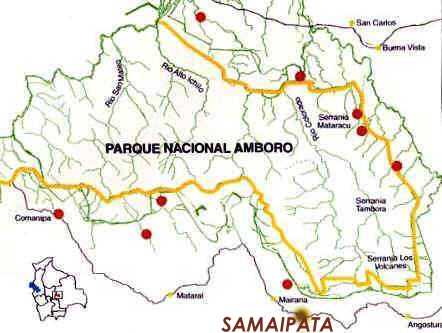The Amboró nature reserve covers 637,600 hectares, divided into 2 categories: National park with 442,500 hectares, and a natural area with limited agricultural use of 195,100 hectares, the park has differences in height from 300 to 3,200 meters in altitude.
Amboró is located in the provinces Manuel Maria Caballero, Ichilo, Florida and Andres Ibañez, it comprises 9 districts: Comarapa, Buena Vista, Samaipata, Yapacaní, San Carlos, Mairana, El Torno, Pampa Grande y Porongo. It is the area where the river basins of the Rio Grande, Ichilo, Yapacaní and Piraí emerge, each of them connected with the Amazon. |
 |
| Amboró has an average annual temperature of 12º C. in the south and 24º in the north, with rainfall-range: 500(n) to 4,000 mm (s). In this zone meet 3 geographical and biological dimensions: the Andes, the Amazon and Chaco. That is why there are 26 different vegatation-areas and about 3,000 plant species registered, although there might be even more than 3500 species....Up till now, 109 species have been found, many of probably endemic or exclusive in this region. Also, 76 Amphibian species has been found of which half of them in Bolivia existing "Anuros" (frogs without tail); 9 of them are endemic .. |
|
